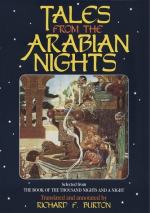[FN#164] The “Father of going out (to prey) by morning”; for dawn is called Zanab Sirhan the Persian Dum-i-gurg=wolf’s tail, i.e. the first brush of light; the Zodiacal Light shown in morning. Sirhan is a nickname of the wolf—Gaunt Grim or Gaffer Grim, the German Isengrin or Eisengrinus (icy grim or iron grim) whose wife is Hersent, as Richent or Hermeline is Mrs. Fox. In French we have lopez, luppe, leu, e.g.
Venant a la queue, leu, leu,
i.e. going in Indian file. Hence the names D’Urfe and Saint-Loup. In Scandinavian, the elder sister of German, Ulf and in German (where the Jews were forced to adopt the name) Wolff whence “Guelph.” He is also known to the Arabs as the “sire of a she-lamb,” the figure metonymy called “Kunyat bi ’l-Zidd” (lucus a non lucendo), a patronymic or by-name given for opposition and another specimen of “inverted speech.”
[FN#165] Arab. “Bint’ Arus” = daughter of the bridegroom, the Hindustani Mungus (vulg. Mongoose); a well-known weasel-like rodent often kept tame in the house to clear it of vermin. It is supposed to know an antidote against snake-poison, as the weasel eats rue before battle (Pliny x. 84; xx. 13). In Modern Egypt this viverra is called “Kitt (or Katt) Far’aun” = Pharaoh’s cat: so the Percnopter becomes Pharaoh’s hen and the unfortunate (?) King has named a host of things, alive and dead. It was worshipped and mummified in parts of Ancient Egypt e.g. Heracleopolis, on account of its antipathy to serpents and because it was supposed to destroy the crocodile, a feat with AElian and others have overloaded with fable. It has also a distinct antipathy to cats. The ichneumon as a pet becomes too tame and will not leave its master: when enraged it emits an offensive stench. I brought home for the Zoological Gardens a Central African specimen prettily barred. Burckhardt (Prov. 455) quotes a line:—
Rakas’ Ibn Irsin wa zamzama
’l-Nimsu,
(Danceth Ibn Irs whileas Nims doth
sing)
and explains Nims by ichneumon and Ibn Irs as a “species of small weasel or ferret, very common in Egypt: it comes into the house, feeds upon meat, is of gentle disposition although not domesticated and full of gambols and frolic.”
[FN#166] Arab. “Sinnaur” (also meaning a prince). The common name is Kitt which is pronounced Katt or Gatt; and which Ibn Dorayd pronounces a foreign word (Syriac?). Hence, despite Freitag, Catus (which Isidore derives from catare, to look for) = gatto, chat, cat, an animal unknown to the Classics of Europe who used the mustela or putorius vulgaris and different species of viverrae. The Egyptians, who kept the cat to destroy vermin, especially snakes, called it Mau, Mai, Miao (onomatopoetic): this descendent of the Felis maniculata originated in Nubia; and we know from the mummy pits and Herodotus that it was the same species as ours. The first portraits of the cat are on the monuments of “Beni Hasan,”




